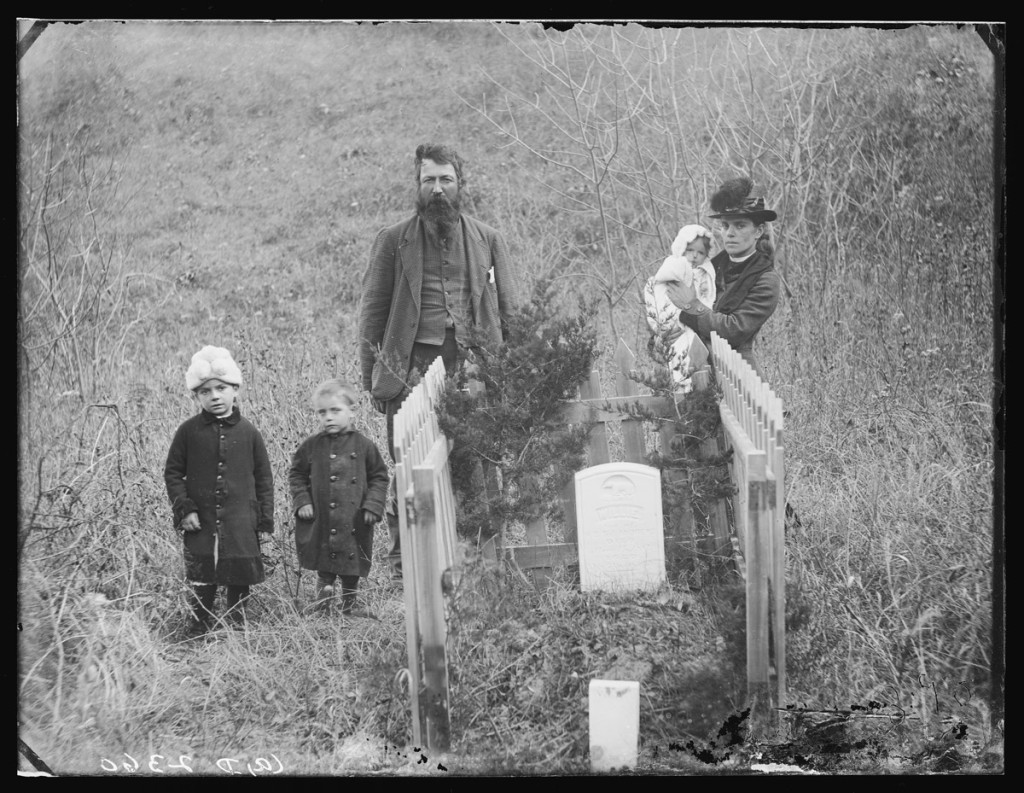 The Harvey Andrews family of Custer County at the grave of their son, Willie, in 1887. The marker includes a sleeping lamb motif typical of Victorian-era symbolism. NSHS RG2608.PH-2360a
The Harvey Andrews family of Custer County at the grave of their son, Willie, in 1887. The marker includes a sleeping lamb motif typical of Victorian-era symbolism. NSHS RG2608.PH-2360a
One way that historians study social history is by looking at the way people deal with commonplace happenings in their lives. For example, no one can escape dying. Attitudes and customs relating to death and dying tell a lot about human relationships, about religious beliefs, and about culture in general. The Victorian era was noted for ornamentation and symbolism that carried over into the Victorian outlook toward death. This symbolism can be seen in gravestone motifs of the period, such as draped or parted curtains, fingers pointing toward heaven, or sleeping lambs atop the stones of children. Such symbolic devices are rarely found on modern gravestones, although the trend now seems to be toward personalized stones with motifs reflecting the deceased’s occupation or hobbies. If one reads nineteenth century Nebraska newspapers, it will be apparent that the way death and dying was described in the Victorian era is very different from the way it is treated now. Today’s obituary writers seek objectivity and brevity and do not avoid using the word “death,” while Victorians really did not die at all, at least according to many newspaper accounts. They left this world in a variety of ways that shrouded direct mention of death. Nineteenth and early twentieth century obituary writers often required several columns laden with metaphors and personifications to get the deceased person safely into heaven. And invariably, heaven is where the person was bound because Victorians were nothing if not optimistic about the eventual fate of even the most despicable mortal, or at least they were too polite to suggest otherwise in print. Victorian metaphors for dying took many forms, as did the personifications of death. Some draw upon the cycle of planting, nurturing, and harvesting: “The stern reaper found him as a shock of corn, fully ripe for the harvest.” Similar metaphors were applied to the death of a child (Mabel Yates 1880): “Only seven summers was this rare sweet blossom permitted to bloom on earth. God saw fit to transplant it into the angels’ garden, safe from the dangers of this life.” Another young child’s death was likened to “a rosebud torn from the stem.” A person’s life was often described in terms of a day’s work. The human heart was a clock, slowly ticking away the minutes of life’s day. When the clock strikes midnight, it stops. Sometimes the euphemisms for death were based on the person’s occupation or activities in life. Civil War veterans did not die, they “answered the last roll call and went to join the great commander.” Veteran Freeman Carey of Greeley, Nebraska, ate supper and went to bed. “Shortly afterwards his wife went to his bedside only to find that he had been mustered out with an honorable discharge.” Death in Victorian times was commonly portrayed as a journey, as it is today. Metaphors likening the deceased to a sailing ship were common; the death of one woman was described as “only a little groaning of the timbers, a little creaking of the stays, and her well-built bark calmly sailed away to join the mighty fleet on the eternal sea.” One obituary I found combines many of the common symbolic devices: a personification of death along with metaphors for a journey and the passage of the deceased through a curtain. “Again the black-plumed Knight of death, with his silent hand, has loosened from its earthy moorings another of life’s frail barques and launched it on that silent river and has drawn the sable curtains through which the tearful eyes of loving friends who stand on the brink of the boundless river can never penetrate.” The notion of a journey or passage is conveyed by common expression that someone is “lying at death’s door.” An excessively morbid personification of death that, nonetheless, is solidly Victorian is an example from a Sidney newspaper in 1879: “Death’s grim presence appeared here on Saturday when his cold fingers froze the warm life currents in the veins of Mrs. Lane.” Euphemisms for death persist to the present day although many of the more modern ones lack the lofty sentiments of the Victorian era, for example, “kick the bucket,” “bought the farm,” or “cashed in his chips.” Today, “Passed away,” “at rest,” and “departed this life” are often used in funeral home folders and it is common to speak of “losing” someone close to us. Nebraska folklorist Louise Pound suggested that euphemistic references to death are an attempt to give it a melancholy romance or a noble dignity. Some such efforts succeed, while others are pointless substitutes for straightforward speech. A good example she noted was the rattled clergyman who said, pointing to the corpse, “This is only the shell, the nut is gone.” The Victorian penchant for properly noting the passage of the near and dear into the next world is reinforced by unusual examples. The deaths of Fannie, Tom, and Nellie were reported in separate newspaper accounts. Fannie was a great-great grandmother, and stood at the head of thirty-eight of her family. Her loss was deeply felt. Tom had earned the admiration of everyone who knew him and was noted for his intelligence. Nellie had gone through the grasshopper plague and all the hard times attending it, and left behind a large family of offspring to mourn her loss. These obituaries for horses appeared in newspapers and they well represent the Victorian attitude toward death. — James E. Potter, Senior Research Historian



